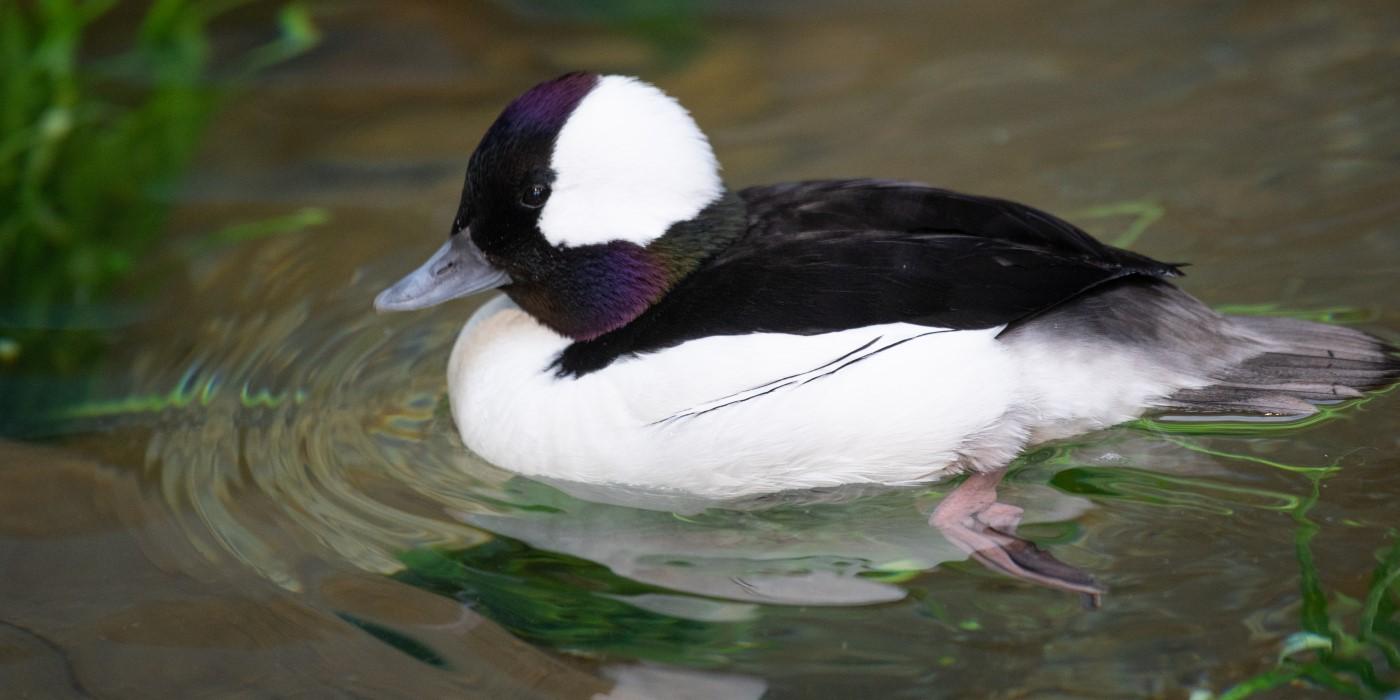Physical Description
Buffleheads were named for their seemingly large head relative to their small size. Females are colored with various shades of gray or brown, except for a small white patch on their face, just under and behind their eyes. The rest of the females’ heads and backs are darker than their bodies. Male buffleheads look similar to females until they are about a year old. During breeding season, adult males develop plumate patterns that include a white body and dark back. Their head is either black or iridescent purple and green. A white patch extends from the back of their eyes and around the back of their head.
Male buffleheads have a large, white stripe on their wing, close to their shoulder, which only can be seen while they are in flight. While females do not have this stripe, they do have a smaller white patch on their wings. This patch is visible while the females are in flight and sometimes while their wings are closed.
Diving ducks’ legs are set farther back on their bodies than other duck species’ legs. While this placement helps the ducks more efficiently propel when diving, it makes them clumsy on land.
Size
Buffleheads are the smallest diving duck in North America. These ducks grow up to 15 inches long (40 centimeters) and weigh about a pound (0.45 kilograms) on average. Their wingspan measures around 2 feet (60 centimeters) long.
Native Habitat
From October to April, buffleheads winter along the coastlines. No specific area hosts the majority of the population, but they can be found from Alaska to Mexico and Newfoundland to Florida. Buffleheads mostly migrate at night. Their breeding grounds are primarily in western and central Canada. A few small populations can be found in the Northwestern United States. and eastern Alaska. Buffleheads breed by ponds and small lakes in coniferous and deciduous mixed forests. It’s believed these ducks stay on their chosen body of water until the first freeze in the fall and return as soon as the water thaws in the spring.
Lifespan
Wild buffleheads live an average of 2.5 years but can live up to 18 years.
Communication
During courtship, a male bufflehead will give a chattering-like song as he throws his head back and quickly bobs it up and down. An interested female will respond with a guttural “cuk-cuk-cuk” sound that makes her body look as if it is shaking.
Food/Eating Habits
Buffleheads dive for their food. Small flocks may all dive concurrently. These diving ducks forage and swallow their food whole while underwater.
Their diet varies by season and location. Throughout the summer and on freshwater bodies of water, buffleheads eat more aquatic insects. While on ocean coasts, these diving ducks mainly eat crustaceans. Buffleheads also eat large quantities of mollusks in the winter and some aquatic plants in the fall. They have also been known to eat small fish on occasion.
Social Structure
One of the less social ducks, buffleheads are most often in pairs or small groups. Pairs mostly form in the spring. Bufflehead pairs are monogamous and will stay together for several years.
Reproduction and Development
Buffleheads nest in tree cavities. Since they are so small, females often choose to use old nest holes of another bird, the Northern flicker. These nest cavities are typically 2-10 feet above the ground but can be up to 50 feet high. Some pairs have been known to use the same nest site for several years. These birds use a minimal amount of nest materials, only using down feathers.
A female will lay eight to 10 eggs and incubates them for about a month before they hatch. Within the first two days of life, bufflehead chicks leave the nest and follow their mother to water. It’s not uncommon for two broods to join or for a separated duckling to join another brood. While the mother will look after the chicks, the young generally forage for food by themselves. Bufflehead chicks can fly between 50 and 55 days old.
Conservation Efforts
Overall, the bufflehead population is stable and has increased substantially since the 1950s, after the enactment of several laws and regulations intended to limit duck hunting. Now, they are most at risk of losing their nesting habitat to agriculture and development.
Help this Species
Reduce, reuse and recycle — in that order! Cut back on single-use goods, and find creative ways to reuse products at the end of their life cycle. Choose recycling over trash when possible.
Practice ecotourism by being an advocate for the environment when you’re on vacation. During your travels, support, visit or volunteer with organizations that protect wildlife. Shop smart too! Avoid buying products made from animals, which could support poaching and the illegal wildlife trade.
Organize or attend a stream, river, lake or other waterway cleanup in your area to preserve aquatic habitats for local species.
Support organizations like the Smithsonian’s National Zoo and Conservation Biology Institute that research better ways to protect and care for this animal and other endangered species. Consider donating your time, money or goods.
Conservation starts with you! Join a citizen science project where you can help collect valuable data for scientists. Encourage your friends and family to get involved too.
Protect local waterways by using fewer pesticides when caring for your garden or lawn. Using fertilizers sparingly, keeping storm drains free of litter and picking up after your pet can also improve watershed health.
Share the story of this animal with others. Simply increasing awareness and educating others about the threats invasive species pose to local ecosystems can help protect native environments.
Smithsonian's National Zoo and Conservation Biology Institute. (n.d.). Bufflehead. Retrieved January 4, 2026, from https://nationalzoo.si.edu/animals/bufflehead



